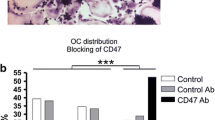Summary
An immunocytochemical method using an antibody against 5-bromo-2′-deoxyuridine has been applied to the study of the kinetics of osteoclast nuclei on intact mouse parietal bones. Osteoclasts containing tartrate-resistant acid phosphatase show nuclei that are positive for the thymidine analogue within 24 hours of injection into four-day old mice. Labelled osteoclast nuclei decline in number with a half-life of 1.3 days, compatible with a random mechanism of cell death rather than a fixed lifespan. This is shorter than has previously been reported and the possible reasons for this are suggested. The main advantages compared with autoradiography are the shortened processing time and the large number of osteoclasts that can be examined per parietal bone.
Similar content being viewed by others
References
Abe, K., Ohno, K. &Hasegawa, K. (1990) Morphological relationships between osteoclasts and bone resorption surfaces on mouse parietal bones.Arch. Histol. Cytol. 53, 95–102.
Addison, W. C. (1979) The distribution of nuclei in imprints of feline osteoclasts.J. Anat. 129, 63–8.
Biggers, W. J., Barnea, E. R. &Sanyal, M. K. (1987) Anomalous neural differentiation induced by 5-bromo-2′-deoxyuridine during organogenesis in the rat,Teratology 35, 63–75.
Ellwart, J. &Dormer, P. (1985) Effect of 5-fluoro-2′-deoxyuridine (FdUrd) on 5-bromo-2′-deoxyuridine (BrdUrd) incorporation into DNA measured with a monoclonal BrdUrd antibody and by the BrdUrd/Hoechst quenching effect.Cytometry 6, 513–20.
Fischman, D. A. &Hay, E. D. (1962) Origin of osteoclasts from mononuclear leukocytes in regenerating newt limbs.Anat. Rec. 143, 329–34.
Gratzner, H. G. (1982) Monoclonal antibody to 5-bromo-and 5-iododeoxy-uridine: a new reagent for the detection of DNA replication.Science 218, 474–5.
Gungor, T., Hedlund, T., Hulth, A. &Johnell, O. (1982) The effect of irradiation on osteoclasts with or without transplantation of hematopoietic cells.Acta Orthop. Scand. 53, 333–7.
Hancox, N. M. (1956) The osteoclast. InThe Biochemistry and Physiology of Bone (edited byBourne, G.) pp. 213–47. New York: Academic Press.
Hattersley, G., Kerby, J. A. &Chambers, T. J. (1991) Identification of osteoclast precursors in multilineage hemopoietic colonies.Endocrinology 128, 259–62.
Jaworski, Z. F. G., Duck, B. &Sekaly, G. (1981) Kinetics of osteoclasts and their nuclei in evolving secondary Haversian systems.J. Anat. 133, 397–405.
King, M.-T., Wild, D., Gocke, E. &Eckhardt, K. (1982) 5-Bromodeoxyuridine tablets with improved depot effect for analysis in vivo of sister-chromatid exchanges in bone-marrow and spermatogonial cells.Mutat. Res. 97, 117–29.
Loutit, J. F. &Townsend, K. M. S. (1982) Longevity of osteoclasts in radiation chimaeras of osteopetrotic beige and normal mice.Br. J. Exp. Path. 63, 221–3.
Marks, S. C. &Seifert, M. F. (1985) The lifespan of osteoclasts: experimental studies using the giant granule cytoplasmic marker characteristic of beige mice.Bone 6, 451–5.
Miller, M. W. &Nowakowski, R. S. (1988) Use of bromodeoxyuridine-immuno-histochemistry to examine the proliferation, migration and time of origin of cells in the central nervous system.Brain Res. 457, 44–52.
Scheven, B. A. A., Burger, E. H., Kawilarang-Dehaas, E. W. M., Wassenaar, A. M. &Nijweide, P. J. (1985) Effects of ionizing irradiation on the formation and resorbing activity of osteoclastsin vitro.Lab. Invest. 53, 72–9.
Tinkler, S. M. B., Linder, J. E., Williams, D. M. &Johnson, N. W. (1981) Formation of osteoclasts from blood monocytes during 1-OH Vit D-stimulated bone resorption in mice.J. Anat. 133, 389–96.
Van Furth, R. &Cohn, Z. A. (1968) The origin of mononuclear phagocytes.J. Exp. Med. 128, 415–35.
Young, R. W. (1962) Cell proliferation and specialization during endochondral osteogenesis in young rats.J. Cell Biol. 14, 357–70.
Author information
Authors and Affiliations
Rights and permissions
About this article
Cite this article
Marshall, M.J., Davie, M.W.J. An immunocytochemical method for studying the kinetics of osteoclast nuclei on intact mouse parietal bone. Histochem J 23, 402–408 (1991). https://doi.org/10.1007/BF01042296
Received:
Revised:
Issue Date:
DOI: https://doi.org/10.1007/BF01042296




